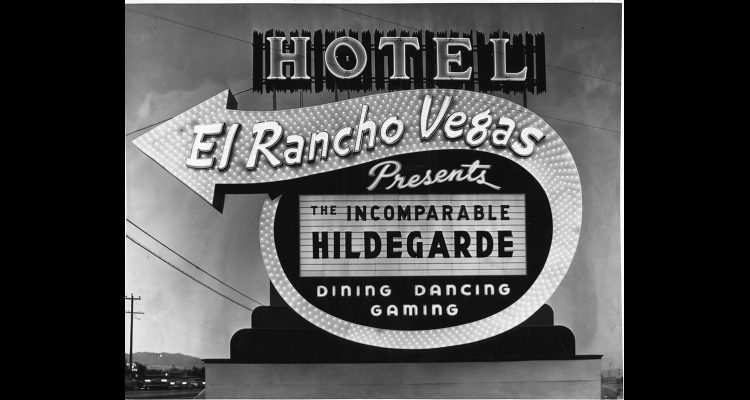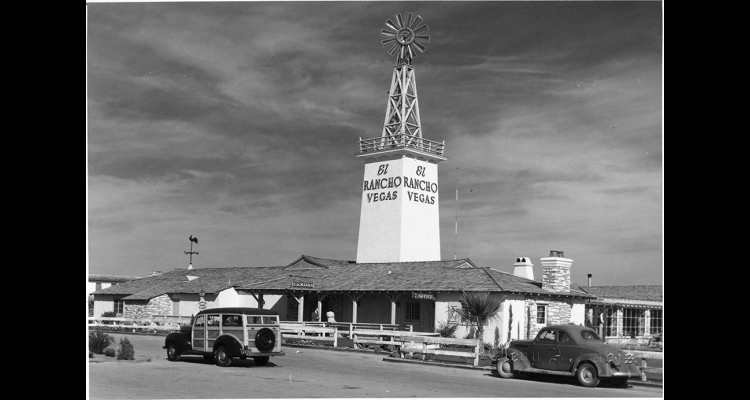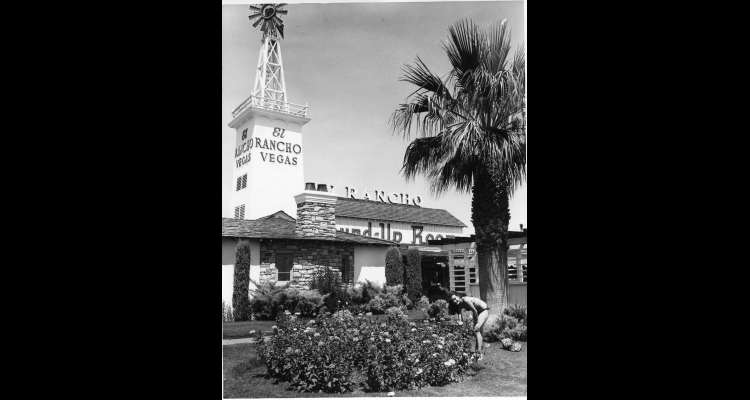El Rancho Vegas
In Las Vegas in the late 1930s, when casino gambling was concentrated on Fremont Street downtown, a number of would-be casino developers speculated about the potential of building a casino resort outside of town on Highway 91, where increasing numbers of tourists were arriving from Los Angeles and elsewhere. But no one could put a deal together, and the highway served as home to a handful of roadhouses, like the Pair-O-Dice.
Thomas Hull, who had operated seven hotels in California including the Hollywood Roosevelt in Los Angeles, would be the first to launch a resort on the Las Vegas Strip. In 1940, Las Vegas businessmen Robert Griffith and James Cashman approached Hull, who had recently opened motor hotels, each named "El Rancho," in Fresno and Sacramento, about scouting out a location in Las Vegas.
According to local accounts of the time, while Hull was driving down Highway 91 to Las Vegas with a friend in 1940, about two miles south of downtown, his car had a flat tire. His friend hitchhiked to town for help. While waiting, Hull is said to have thought about how it would be to dive into a swimming pool. He watched as cars, many with out-of-state license plates, drove by the undeveloped desert area.
As the story goes, after counting the passing cars on the highway, Hull decided it would be an ideal place to build a resort with deluxe accommodations, unlike the downtown hotels. Cashman would later show Hull some potential casino sites downtown and just off of Fremont Street, but Hull surprised locals by opting for the highway area instead.
Another factor that drove Hull to build in Las Vegas was that the munitions industry in Southern California during the war in Europe was growing. He rightly figured southern Nevada would soon house a military base for training American forces, bringing more money to Las Vegas.
Hull bought a large corner parcel on present-day Sahara Avenue and the highway at what he saw as a very low price. The site was in Clark County, just outside the Las Vegas city limits, and so Hull would avoid having to pay higher city taxes. The architectural firm McAllister and McAllister designed a theme combining a Spanish-style exterior with a cowboy, frontier-type of interior.
The resort's low-rise buildings housed a showroom, a cocktail lounge, casino, steakhouse, and a few stores. For late nighters, its Chuck Wagon buffet service included a free breakfast and coffee from 4:15 to 6:30 a.m. Its dining room, with 250 seats, was the largest in Las Vegas. Most of the sixty-three guest rooms were bungalows. Outside, patrons could walk to stables for horse riding. Its rear swimming pool prompted locals and tourists to regard the El Rancho as the first authentic resort in Las Vegas, which was practically transformed overnight.
The El Rancho Vegas, built at a cost of under $500,000, was an immediate success. It opened on April 3, 1941. Its trademark was its tower sign on the casino building, topped by a large, farm-type windmill with neon-lit blades that attracted motorists at night. Its showroom, no doubt an inspiration for other Strip and Fremont Street hotels to come, featured a line of sexy dancers from California, called the "El Rancho Starlets," who performed with a live orchestra. The hotel's evening dinner show had a "come as you are" policy that tolerated its customers who arrived in informal dress. The hotel's luxury services soon made it a draw for Hollywood celebrities.
In its early years, however, although still a success, the El Rancho suffered from constant management turnover. Hull quickly sold the El Rancho. The hotel changed owners several times. At one point, its operators were Sanford Adler, later barred from Nevada gaming, and Charlie Resnik, who was allegedly connected with Detroit's "Purple Gang." One of its part-owners in the mid-1940s was Wilbur Clark, before he started the Desert Inn on the Strip. Beldon Katleman bought the El Rancho in 1947, and would soon arrange for renovations to keep up with the newer fancier, hotels such as the Flamingo.
Katleman invested about $750,000 in improvements, replacing the hotel's quaint Western-style interior with a French Provincial design, and adding 220 hotel rooms. The El Rancho's expanded casino was, briefly, the largest casino—18,000 square feet—in Nevada. Throughout the 1950s, it served as the venue for many popular but middle-level entertainers, such as bandleader Harry James, film actress Betty Grable, singer Eartha Kitt, exotic dancer Lili St. Cyr, and standup comic Joe E. Lewis.
Disaster struck on June 17, 1960, when a devastating, pre-dawn, wind-swept fire quickly burned through the El Rancho, which became almost a total loss. As people watched on the Strip, the hotel's trademark windmill collapsed into the flames. Although some suspected arson, firefighters could find no evidence the fire was deliberately set and speculated it was an accident.
The El Rancho never reopened. Katleman, though he pledged to rebuild it, never did. He moved to Los Angeles after collecting on his fire insurance policy. Billionaire Howard Hughes later bought the empty site, but the land, across from the Sahara Hotel, would remain vacant for more than forty years. In 2004, Hilton used part of the site to build a 1,200-room timeshare tower.
Article Locations
Related Articles
None at this time.
Further Reading
None at this time.



